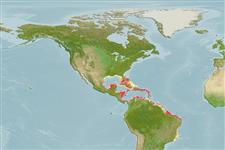Common names from other countries
Environment: milieu / climate zone / depth range / distribution range
Écologie
. Tropical
Distribution
Pays | Zones FAO | Écosystèmes | Occurrences | Introductions
Western Atlantic.
Length at first maturity / Taille / Poids / Âge
Maturity: Lm ? range ? - ? cmCommon length : 9.8 cm TL mâle / non sexé; (Ref. 344)
Description synthétique
Morphologie
Shell subcircular, heavy, inequivalve. Shell surface smooth except for fine, irregular growth lines. Hinge well developed, with posterior lateral tooth long and strong. Pallial sinus large, well developed. Umbones at central part of dorsal region. Oblique ridge runs from umbo to middle of posterior margin. Posterior shell margin sinuous in posterior view: posterior margin of right valve concave and of left valve concave. Colour: externally white, internally glossier white with yellow tinges.
In shallow water, deeply burrowing in intertidal sand near seagrass beds (Ref. 344).
Life cycle and mating behavior
Maturité | Reproduction | Frai | Œufs | Fécondité | Larves
Members of the class Bivalvia are mostly gonochoric, some are protandric hermaphrodites. Life cycle: Embryos develop into free-swimming trocophore larvae, succeeded by the bivalve veliger, resembling a miniature clam.
Leal, J.H. 2003. (Ref. 344)
Statut dans la liste rouge de l'IUCN (Ref. 130435)
statut CITES (Ref. 108899)
Not Evaluated
Not Evaluated
Utilisations par l'homme
Pêcheries: commercial
| FishSource |
Outils
Plus d'informations
Taille/ÂgeCroissanceLongueur-poidsLongueur-longueurMorphologieLarvesAbondance
Sources Internet
Estimates based on models
Catégorie de prix
Unknown.
